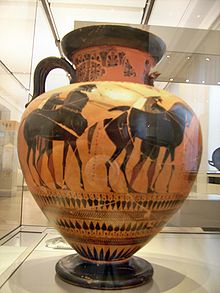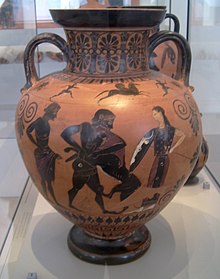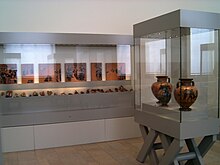Neck amphora des Exekias (Berlin F 1720)
The neck amphora of Exekias is a black-figure style amphora by the Attic potter and vase painter Exekias . It is owned by the Berlin Collection of Antiquities , where it is listed under catalog number F 1720 and exhibited in the Altes Museum . It shows on one side the fight of Heracles with the Nemean lion , on the other side Akamas and Demophon , the sons of Theseus . The sons of Theseus are shown on this vase for the first time in Attic art.
Dating and painter
The amphora is dated around 545/40 BC. Dated and is executed in the black-figure style common at the time . On the edge of the mouth there is a signature that Exekias names both as a potter and as a painter of the vase ("Ἐχσεκιας εγραφσε καποεσε εμε", "Exekias egraphse kai poese me '" - "Exekias painted and made me"). The painter Exekias is considered a master of black-figure vase painting, which he led to its artistic climax. He introduced some innovations and improvements, some of which are also used in this amphora.
description
The clay neck amphora is 40.5 cm high. The vase is fragmented but largely preserved. What is particularly striking is the lack of one of the two handles, and some fragments of the vase body are missing. The parts received are in good condition.
Both sides of the amphora are framed in the belly zone both above and below by chains of painted and stylized lotus flowers and lotus buds. The handle zones are decorated with volutes and palmettes . The pictures on both sides are equally important and not, as was usually the case in later times, divided into a front main picture and a less eye-catching picture on the back.
On one side the fight between Heracles and the Nemean lion is depicted and thus shows one of the twelve tasks that the son of Zeus has to carry out on behalf of King Eurystheus . Heracles strangles the otherwise invulnerable lion in the presence of his brother Iolaos and the goddess Athena , who is interested in the fight, but practically indifferent. They look like they're narrowing the battlefield. The naked Heracles has put his left arm around the neck of the lion and is holding one of the lion's paws in his right hand. The lion tries to free himself from the grip of the hero. Some details are highlighted in red, such as the beards of the brothers, the shield of Athena or parts of the lion's mane. On the other side of the vase, the two sons of Theseus , Akamas and Demophon, can be seen with their horses, who, like the human heroes, are named as Kaliphora and Phalios by inscriptions . Between the two horses, which are led to the right by their owners, runs a vertical favorite inscription : " Onetorides kalos " ( Onetorides is beautiful ). Both men carry their large round shields hanging over their backs and two spears on each shoulder. The shields are highlighted in white body color. The helmets have tall bushes set in red. The sons of Theseus are shown here on their departure for the Trojan War .

The images can be understood as a juxtaposition of two Greek regions that often competed with one another. Heracles is the hero of the Peloponnese , the sons of Theseus represent the Attic-Athenian self-image. The sons of Theseus are shown for the first time in Attic art on this vase. The scene of the beginning of the Trojan War in particular shows the Athenians' growing self-confidence. The participation in the legendary Trojan War of their heroes symbolically lifts Athens into line with the tradition-conscious city-states of the Peloponnese, including the dominant power of the time, Sparta . In the future, the sons of Theseus became carriers and symbols of the new self-confidence of the Athenian aristocracy in Attic art. The fight between Heracles and the Nemean lion is a common motif in black-figure vase painting of this time.
History of finds and restoration
In addition to its art-historical significance, the fate of the vase and individual parts of the vase has been of archaeological and historical interest since they were discovered. The vase was found in the Etruscan necropolis at Ponte dell'Abbadia near Vulci . In Athens, vases were largely produced for export to Etruria , where they were often used as grave goods. Therefore, many of the works of Exekias were found in Etruscan tombs. When it was found, the Etruscan tombs near Vulci had been excavated since 1828, the vase was broken and probably no longer intact. Apparently, the still found fragments were only put together very carelessly. According to today's knowledge, the restorers added the vase incorrectly in some cases. As was customary in the middle of the 19th century, missing areas were also painstakingly painted over to give the impression of a complete work of art. After the restoration, the vase came into the possession of the painter Eduard Magnus . Buying such smaller works of art was fashionable at the time, especially when you couldn't afford other, more expensive and highly valued works of art such as ancient statues or jewelry. Together with other of his pieces, known as the Dorow-Magnus collection , the amphora found its way into the newly founded Museum am Lustgarten only a little later, in 1831 . It stood in the basement of the museum together with other exhibits from the field of cabaret . According to the collection catalog from 1834 written by Konrad Levezow , the vase stood on one of the prominent glass tables. When the cabaret collection was moved to the Neues Museum , the amphora of Exekias was also brought there.
In the 1920s, the vase had to be restored again for reasons that can no longer be verified today. Most of the retouching and additions from the first restoration were removed. Now the additions were distinguishable from the original pieces. With the war-related closure and relocation of the artefacts, Berlin F 1720 was also stored in Kiste 167 in the zoo bunker. In 1945 the box came to the Soviet Union as looted art . In the course of the return of art to the GDR in 1958 - unlike several other pieces in box 167 - the vase was returned to the Berlin Collection of Antiquities, which was now divided into two parts: East and West Berlin . The Exekias vase was one of the few vases that came to the Pergamon Museum in East Berlin , as the majority of the vase inventory was stored in the warehouse, the warehouse inventory was stored in a different location and, after the war, formed the basis of the West Berlin collection of antiques in Charlottenburg . The amphora was presented in the permanent exhibition of the museum.
In the 1970s, while working on a volume from the Corpus Vasorum Antiquorum in the Staatliche Antikensammlungen in Munich , the archaeologist Erika Kunze-Götte found a two-part fragment that she suspected belonged to the Exekias amphora. In the period that followed, a brisk correspondence between Munich and East Berlin began. Photos and outline drawings were exchanged and measurements were taken. A silicone cast finally confirmed that the pieces belonged together. Presumably the individual pieces were found later or were wrongly not recognized as belonging together. When considering whether to make an exchange or agree on a permanent loan , they agreed on an exchange. As an exchange object, the antique collections in Munich were to receive an ornamentally painted black-figure polychrome lid from the Pergamon Museum. Although an agreement was reached on a scientific basis so quickly, there was a considerable delay, as the GDR authorities needed seven years to approve the exchange deal. On January 7th, 1988 the pieces were exchanged in Munich.
After the merging of the pieces, the vase had to be restored again from 1990. First an attempt was made to cut out the old addition and insert the new fragment. It was found that the defect was too small by the earlier restorers. So the vase had to be taken apart. But this ultimately turned out to be a stroke of luck. For example, the restorer Priska Schilling found the letter o of the inscription (I) olaos under old overpaintings . In addition, a still original handle was found on the added handle. On several of the inside of the broken glass there were delicate incised inscriptions such as “ o pais kalos ” (“the boy is beautiful”) and “ kalos ” (“beautiful”). It is believed that this was a joke by an earlier restorer, possibly Domenico Campanari in the first half of the 19th century. In 1991 the restoration of the vase was completed.
Today, the vase is in the Altes Museum exhibited where they, along with the grave tablets of Exekias of the amphora and F 1717 Group E is presented. The amphora from the same period also shows the fight of Heracles with the Nemean lion.
literature
- Adolf Furtwängler : Description of the vase collection in the Antiquarium . Berlin 1885, pp. 265-268 No. 1720 ( digitized version ).
- John D. Beazley : Attic Black-figure Vase-painters . Clarendon Press, Oxford 1956, pp. 143-144 No. 1.
- Ursula Kästner : A German-German vase fate . In: EOS. Messages for friends of antiquity on Museum Island Berlin 9 November 1999, pp. VII – IX.
- Ursula Kästner: Amphora of the potter and vase painter Exekias . In: Andreas Scholl , Gertrud Platz-Horster (eds.): Altes Museum. Pergamon Museum. The antique collection. Philipp von Zabern, Mainz 2007, ISBN 978-3-8053-2449-6 , pp. 56–57 No. 26.
- E. Anne Mackay: Tradition and Originality: A Study of Exekias (= British Archaeological Reports International Series 2092). Archaeopress, Oxford 2010, ISBN 978-1-4073-0568-4 , pp. 117-133, No. 11, plates 30-32.
- Heide Mommsen : Berlin, Antikensammlung 14 (= Corpus Vasorum Antiquorum Germany 94). CH Beck, Munich 2013, ISBN 978-3-406-65335-3 , pp. 66–73, plates 31–33 color plate. 3 ( digitized version ).
- Heide Mommsen: Neck amphora . In: Christoph Reusser , Martin Bürge (ed.): "Exekias painted and made pottery for me". Exhibition in the Archaeological Collection of the University of Zurich, November 9, 2018–31. March 2019 . Archaeological Collection of the University of Zurich, Zurich 2018, ISBN 978-3-905099-34-8 , pp. 165–171 No. 6.
Web links
- Pictures and description in the Perseus Digital Library
- Entry in the Beazley Archive Pottery Database
Remarks
- ↑ The description of the vase follows the description by Ursula Kästner: Amphora of the potter and vase painter Exekias . In: Andreas Scholl, Gertrud Platz-Horster (eds.): Altes Museum. Pergamon Museum. The antique collection. Philipp von Zabern, Mainz 2007, ISBN 978-3-8053-2449-6 , p. 57 and the Perseus catalog .
- ↑ See Frank Brommer : Herakles. The twelve deeds of the hero in ancient art and literature . Wissenschaftliche Buchgesellschaft, Darmstadt 1972, ISBN 3-412-90572-0 , pp. 7-11.
- ↑ The presentation of the history of the find follows Ursula Kästner: Ein Deutsch-Deutsches Vasenschicksal . In: EOS. Messages for friends of antiquity on Museum Island Berlin 9 November 1999, pp. VII – IX.
Coordinates: 52 ° 31 '10 " N , 13 ° 23' 54" E



